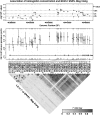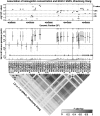Natural selection on EPAS1 (HIF2alpha) associated with low hemoglobin concentration in Tibetan highlanders
- PMID: 20534544
- PMCID: PMC2895075
- DOI: 10.1073/pnas.1002443107
Natural selection on EPAS1 (HIF2alpha) associated with low hemoglobin concentration in Tibetan highlanders
Abstract
By impairing both function and survival, the severe reduction in oxygen availability associated with high-altitude environments is likely to act as an agent of natural selection. We used genomic and candidate gene approaches to search for evidence of such genetic selection. First, a genome-wide allelic differentiation scan (GWADS) comparing indigenous highlanders of the Tibetan Plateau (3,200-3,500 m) with closely related lowland Han revealed a genome-wide significant divergence across eight SNPs located near EPAS1. This gene encodes the transcription factor HIF2alpha, which stimulates production of red blood cells and thus increases the concentration of hemoglobin in blood. Second, in a separate cohort of Tibetans residing at 4,200 m, we identified 31 EPAS1 SNPs in high linkage disequilibrium that correlated significantly with hemoglobin concentration. The sex-adjusted hemoglobin concentration was, on average, 0.8 g/dL lower in the major allele homozygotes compared with the heterozygotes. These findings were replicated in a third cohort of Tibetans residing at 4,300 m. The alleles associating with lower hemoglobin concentrations were correlated with the signal from the GWADS study and were observed at greatly elevated frequencies in the Tibetan cohorts compared with the Han. High hemoglobin concentrations are a cardinal feature of chronic mountain sickness offering one plausible mechanism for selection. Alternatively, as EPAS1 is pleiotropic in its effects, selection may have operated on some other aspect of the phenotype. Whichever of these explanations is correct, the evidence for genetic selection at the EPAS1 locus from the GWADS study is supported by the replicated studies associating function with the allelic variants.
Conflict of interest statement
The authors are listed alphabetically and declare no conflict of interest.
Figures




Comment in
-
Will blood tell? Three recent articles demonstrate genetic selection in Tibetans.High Alt Med Biol. 2010 Winter;11(4):307-8. doi: 10.1089/ham.2010.1052. High Alt Med Biol. 2010. PMID: 21190496 No abstract available.
References
-
- Aldenderfer M. Moving up in the world: Archaeologists seek to understand how and when people came to occupy the Andean and Tibetan plateaus. Am Sci. 2003;91:542–549.
-
- Wu T, Miao C. High altitude heart disease in children in Tibet. High Alt Med Biol. 2002;3:323–325. - PubMed
-
- León-Velarde F, et al. Consensus statement on chronic and subacute high altitude diseases. High Alt Med Biol. 2005;6:147–157. - PubMed
-
- Wu T. Life on the high Tibetan plateau. High Alt Med Biol. 2004;5:1–2. - PubMed
Publication types
MeSH terms
Substances
LinkOut - more resources
Full Text Sources
Other Literature Sources
Medical

